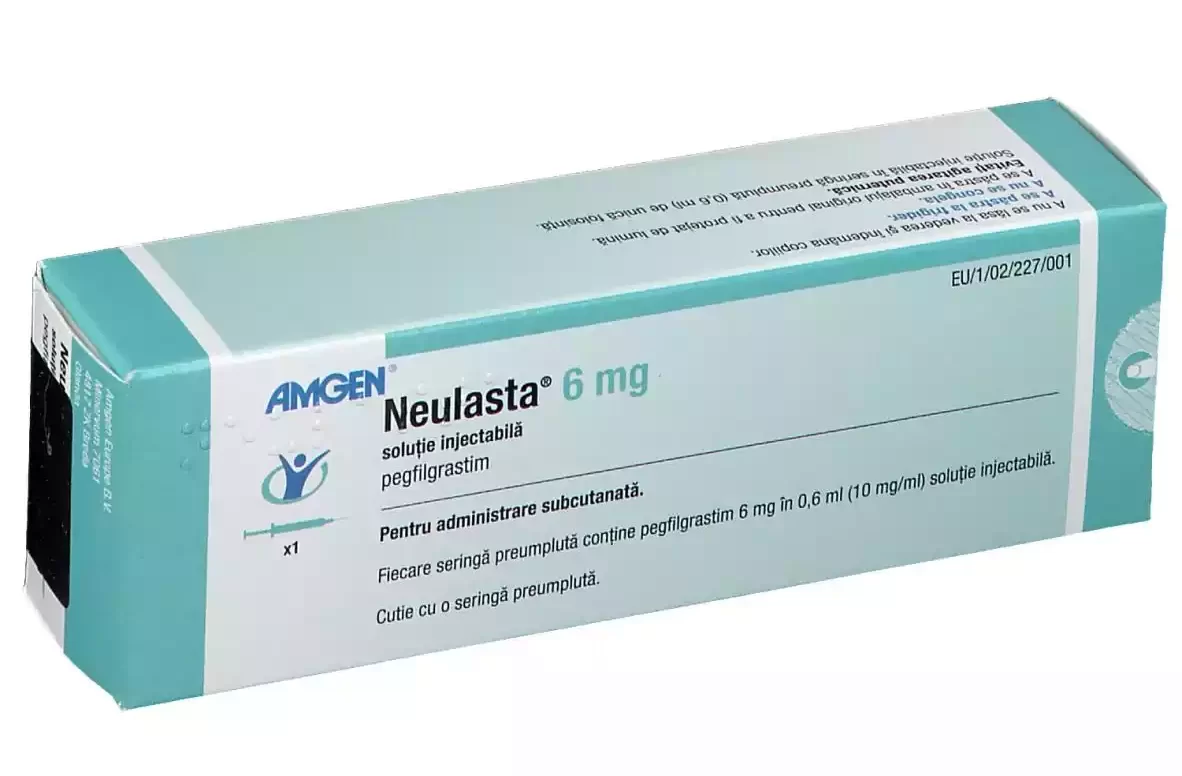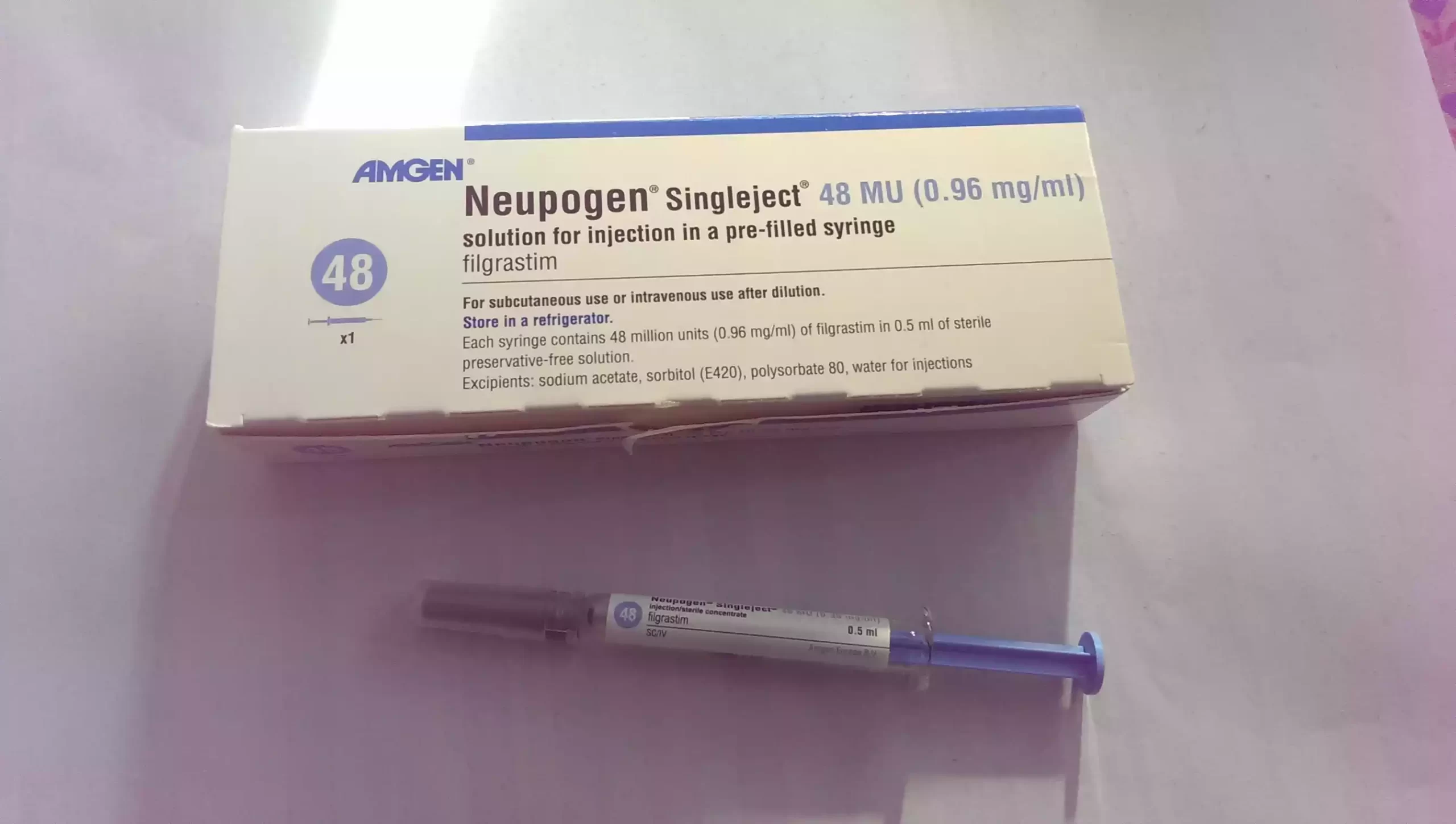Introduction
When it comes to managing neutropenia, a condition characterized by abnormally low levels of neutrophils, Neulasta and Neupogen have emerged as front-runners in treatment options. Both have been hailed for their effectiveness in increasing white blood cell counts in patients undergoing chemotherapy. The two are distinct medications with specific properties, uses, and potential side effects. This article delves into the differences between Neulasta and Neupogen, shedding light on their unique attributes and their significance in the medical field.
Definition Neulasta
Neulasta (pegfilgrastim): Neulasta is a long-acting granulocyte colony-stimulating factor (G-CSF) analog. It is designed to stimulate the bone marrow to produce more neutrophils, a type of white blood cell, to help reduce the risk of infection in patients, particularly those undergoing chemotherapy, who may have a lowered white blood cell count (neutropenia). Neulasta is essentially the molecule filgrastim (the active ingredient in Neupogen) that has been conjugated to a polyethylene glycol (PEG) molecule. The PEGylation process prolongs the duration of its activity in the body, allowing for less frequent dosing compared to filgrastim.

Definition of Neupogen
Neupogen (filgrastim): Neupogen is a granulocyte colony-stimulating factor (G-CSF) that is recombinantly produced. It functions to stimulate the bone marrow to produce and release more neutrophils, a type of white blood cell. This action helps in reducing the risk of infections in patients who may have decreased white blood cell counts, notably those undergoing chemotherapy leading to neutropenia. Unlike Neulasta, which is a pegylated version, Neupogen is a non-pegylated form of the protein, necessitating more frequent dosing to maintain its therapeutic effects.

The Science Behind Them
Both Neulasta and Neupogen are recombinant forms of the naturally occurring granulocyte colony-stimulating factor (G-CSF). They act on hematopoietic cells by binding to specific cell surface receptors, thus stimulating the production, maturation, and activation of neutrophils.
- Neulasta: The addition of the polyethylene glycol (PEG) molecule to filgrastim extends its duration of action. This is because the PEGylation process increases the size of the molecule, reducing renal clearance and prolonging its circulation time in the body.
- Neupogen: Being a non-PEGylated form, it requires more frequent administration than Neulasta.
Primary Uses
Both medications are primarily used to treat neutropenia, especially among cancer patients receiving myelosuppressive chemotherapy.
- Neulasta: Given less frequently, usually after every chemotherapy cycle.
- Neupogen: Administered more often, typically several times a week until the desired neutrophil count is achieved.
Importance of Distinguishing Between Neulasta and Neupogen
Distinguishing between Neulasta and Neupogen is like comparing a marathon runner to a sprinter. Both are athletes, but each shines differently based on the race’s length. Let’s delve into the succinct importance of their distinctions:
- Race Duration (Effectiveness Period): Neulasta, the marathoner, offers a long-lasting effect with just one dose per chemotherapy cycle. Neupogen, the sprinter, packs a punch but for a shorter duration, often requiring multiple administrations in a week.
- Training Frequency (Dosage): Neupogen might demand more frequent “training sessions” or doses, which could be cumbersome for some patients, especially when balancing other treatments and routines. Neulasta’s less frequent dosing offers a reprieve from this.
- Race Strategy (Administration): Neupogen offers flexibility in the “racing style” with both subcutaneous and intravenous administration options. Neulasta is typically subcutaneous, limiting its approach but providing consistent results.
- Hurdles on the Track (Side Effects): While both can cause bone pain, the frequency and intensity might differ. Recognizing which “athlete” or drug suits an individual can drastically improve their treatment experience.
- Race Expenses (Cost): Neulasta’s extended-release often comes with a heftier price tag, akin to the marathoner’s longer race. Weighing the cost versus the convenience becomes crucial in treatment planning.
Understanding these distinctions ensures that healthcare professionals and patients pick the right “athlete” for their unique “race” against neutropenia, optimizing results while balancing convenience, costs, and potential hurdles.
Comparison Table Of Neulasta and Neupogen
Here’s a comparison table for Neulasta and Neupogen:
| Attribute | Neulasta | Neupogen |
|---|---|---|
| Generic Name | Pegfilgrastim | Filgrastim |
| Type | Long-acting G-CSF analog | Short-acting G-CSF |
| Molecular Structure | Pegylated | Non-Pegylated |
| Duration of Action | Extended (due to PEGylation) | Shorter |
| Dosing Frequency | Less frequent (usually once per chemotherapy cycle) | More frequent (often daily or several times a week) |
| Primary Use | Reducing infection risk in neutropenic patients, especially post-chemotherapy | Reducing infection risk in neutropenic patients, especially post-chemotherapy |
| FDA Approval Date | 2002 | 1991 |
| Administration Route | Subcutaneous injection | Subcutaneous or intravenous injection |
| Key Difference | The addition of a polyethylene glycol molecule extends its duration | Requires more frequent administration due to shorter duration |
This table provides a concise comparison between Neulasta and Neupogen, highlighting their primary distinctions.
Similarities between Neulasta and Neupogen
Neulasta and Neupogen, while distinct in their molecular structures and durations of action, also share several similarities. Here are the key similarities between the two medications:
- Origin and Basis: Both Neulasta and Neupogen are recombinant forms of the naturally occurring granulocyte colony-stimulating factor (G-CSF). They are bioengineered in laboratories to mimic the action of natural G-CSF.
- Mechanism of Action: Both drugs function by stimulating the bone marrow to produce and release more neutrophils. This action assists in combating and reducing the risk of infections, especially in patients with compromised white blood cell counts.
- Primary Indication: Both medications are primarily used to treat neutropenia, especially in patients undergoing myelosuppressive chemotherapy. Their primary goal is to boost white blood cell counts and, by extension, bolster the immune system against potential infections.
- Administration: Both drugs can be administered subcutaneously. Neupogen also has the option for intravenous administration.
- Manufacturing Company: Both Neulasta and Neupogen are products of the biotechnology company Amgen.
- Side Effects: Both drugs share some common side effects, such as bone pain and muscle aches. The reactions are due to the increased production of white blood cells in the bone marrow.
- Form: Both are available as injectable solutions, making them suitable for subcutaneous administration.
These similarities underscore why the two drugs are often mentioned together in discussions about neutropenia management and why there’s a need for clarity about their differences in specific clinical scenarios.
Who Should Consider These Medications?
Both Neulasta (pegfilgrastim) and Neupogen (filgrastim) are medications designed to treat or prevent neutropenia, a condition characterized by a decreased number of neutrophils, a type of white blood cell. Neutrophils play a pivotal role in fighting bacterial infections, so a reduced number can significantly increase the risk of infections.

Here are the groups of people who should consider these medications:
- Chemotherapy Patients: One of the most common uses of Neulasta and Neupogen is in cancer patients undergoing myelosuppressive chemotherapy. These treatments can severely depress bone marrow function, leading to a drop in white blood cell counts. By taking either of these medications, patients can reduce their risk of infections during this vulnerable time.
- Bone Marrow Transplant Patients: People who have undergone a bone marrow or stem cell transplant might also benefit from these drugs, especially if their white blood cell counts are slow to recover after the procedure.
- People with Chronic Neutropenia: Some individuals have a chronic condition of neutropenia due to reasons other than chemotherapy or bone marrow transplantation. This includes conditions like congenital neutropenia, cyclic neutropenia, or idiopathic neutropenia. These patients may be prescribed Neulasta or Neupogen as a part of their long-term management strategy.
- Patients Undergoing Radiation: Patients receiving radiation that suppresses bone marrow function may also benefit, especially if they’re expected to have a prolonged period of neutropenia.
- Apheresis Donors: Neupogen, in particular, is sometimes used in healthy donors undergoing apheresis for stem cell collection. The drug stimulates the bone marrow to produce and release more stem cells into the bloodstream, making collection more efficient.
- Patients with HIV: In certain cases, patients with advanced HIV might be prescribed Neupogen if they are experiencing neutropenia as a complication.
Precautions:
- Allergies: Patients who have had allergic reactions to pegfilgrastim, filgrastim, or any of their ingredients should not take Neulasta or Neupogen, respectively.
- Existing Conditions: Individuals with certain conditions, such as sickle cell disease, may experience complications or exacerbations when taking these medications. It’s crucial to discuss any existing health conditions with a healthcare provider.
- Pregnancy and Breastfeeding: The safety of Neulasta and Neupogen during pregnancy and breastfeeding is not fully known. It’s essential to consult with a healthcare provider if you’re pregnant, planning to become pregnant, or breastfeeding.
As always, a healthcare professional should be consulted before starting either medication. They can assess the patient’s specific situation, risks, and benefits to determine the most appropriate treatment plan.
Dosage and Administration
Dosage and administration guidelines ensure that a medication is used in the most effective and safe manner. Here’s a summary of the typical dosage and administration guidelines for both Neulasta and Neupogen. Always consult with a healthcare professional for individual dosing recommendations.
Neulasta (pegfilgrastim)
Dosage:
- The typical dose for adults and pediatric patients weighing more than 45 kg is a single subcutaneous injection of 6 mg, administered once per chemotherapy cycle.
Administration:
- Administered as a subcutaneous (under the skin) injection.
- Injection sites include the abdomen, thigh, or upper arm.
- Do not administer within 14 days before or 24 hours after the use of cytotoxic chemotherapy.
- Neulasta Onpro, an on-body injector, is an option where the device delivers pegfilgrastim over 45 minutes, approximately 27 hours after it’s applied.
Precautions:
- Ensure there’s no hypersensitivity to pegfilgrastim or filgrastim before administration.
- Monitor for potential splenic rupture or acute respiratory distress syndrome.
Neupogen (filgrastim)
Dosage:
- Varies based on the indication, patient’s clinical scenario, and body weight.
- For chemotherapy-induced neutropenia, a common dose is 5 mcg/kg/day.
- Dosage adjustments may be needed based on neutrophil counts and patient’s clinical status.
Administration:
- Can be administered subcutaneously or intravenously (IV).
- For subcutaneous injection, common sites include the abdomen, thigh, or upper arm.
- For IV administration, it’s typically infused over 30 minutes.
- Dosage may need to be adjusted based on the neutrophil response.
Precautions:
- Monitor for potential splenic rupture, acute respiratory distress syndrome, and allergic reactions.
- If subcutaneous injections result in a strong hematologic response, consider adjusting the dose or switching to alternate-day injections.
For both medications:
- Rotate injection sites to reduce the risk of site reactions.
- Always use a new, sterile needle and syringe for each injection.
- Discard any unused portion of the medication; do not save it for a future dose.
- Training may be needed to ensure proper injection technique if patients or caregivers are administering the medication at home.
Again, the actual dosage and administration frequency may vary based on individual patient needs, response, and the specific clinical scenario. Always consult a healthcare professional for guidance.
Personal Experiences with Neulasta and Neupogen
Here’s the personal experiences with Neulasta and Neupogen:
Neulasta (pegfilgrastim)
Positives:
- Efficacy: Many patients find that Neulasta effectively boosts their white blood cell counts after chemotherapy, reducing the risk of infections.
- Less Frequent Dosing: Due to its long-acting nature, patients appreciate the convenience of less frequent injections, typically once per chemotherapy cycle.
Challenges:
- Bone Pain: A commonly reported side effect, some patients experience significant bone pain or muscle aches after taking Neulasta. Over-the-counter pain relievers or prescription medications might be recommended.
- Cost: Some patients have voiced concerns over the high cost of Neulasta, though insurance and assistance programs can sometimes help.
Neupogen (filgrastim)
Positives:
- Effective in Boosting Counts: Like Neulasta, many patients find Neupogen effective in increasing their white blood cell counts and preventing severe neutropenia post-chemotherapy.
- Versatility: Neupogen’s availability for both subcutaneous and intravenous administration offers flexibility.
Challenges:
- Frequent Dosing: Unlike Neulasta, Neupogen often requires more frequent injections, which can be burdensome for some patients.
- Injection Site Reactions: Some patients report redness, swelling, or pain at the injection site.
- Bone Pain: Similar to Neulasta, bone pain or muscle aches are reported side effects. Managing this pain becomes crucial for the well-being of the patient.
While both Neulasta and Neupogen are hailed for their efficacy in managing neutropenia, they come with their own set of challenges. Patients’ experiences can vary, and it’s always recommended to consult with healthcare professionals about potential side effects and individual responses.
Side Effects and Precautions of Neulasta and Neupogen
Both Neulasta and Neupogen are effective in treating neutropenia and bolstering white blood cell counts. As with most medications, they come with potential side effects. Let’s delve into the side effects and precautions associated with each drug:
Neulasta (pegfilgrastim) Side Effects:
Common Side Effects:
- Bone pain
- Muscle aches
- Pain or discomfort at the injection site
- Headache
Less Common but Serious Side Effects:
- Splenic rupture: Enlargement or rupture of the spleen, which can be fatal. Symptoms might include left upper abdominal pain or shoulder tip pain.
- Acute Respiratory Distress Syndrome (ARDS): A severe lung condition.
- Allergic reactions: Symptoms can include skin rash, shortness of breath, wheezing, dizziness, swelling around the mouth or eyes, fast pulse, and sweating.
- Severe sickle cell crises in patients with sickle cell disorders.
- Kidney injury: Indicated by changes in the amount of urine or its color, swelling of feet or ankles.
Precautions:
- Patients should always inform their healthcare provider about any existing conditions or medications they are on.
- Should not be administered in the period 14 days before and 24 hours after chemotherapy.
- Monitor blood counts regularly during treatment.
Neupogen (filgrastim) Side Effects:
Common Side Effects:
- Bone pain
- Muscle aches
- Pain or redness at the injection site
- Fatigue
- Weakness
Less Common but Serious Side Effects:
- Splenic rupture: Similar to Neulasta, symptoms include left upper abdominal pain or shoulder tip pain.
- Acute Respiratory Distress Syndrome (ARDS).
- Allergic reactions: Symptoms might include skin rash, shortness of breath, dizziness, or facial swelling.
- Rapid heartbeat or irregular heart rhythm.
- Blood in the urine or stools.
Precautions:
- As with Neulasta, patients should inform their healthcare provider about their medical history and other medications.
- Regular monitoring of blood counts during treatment is essential.
- Patients with a history of sickle cell disease should be monitored for potential sickle cell crises.
For both drugs, if any unusual or severe symptoms occur, it’s crucial to seek medical attention promptly. Always use these medications under the guidance of a healthcare professional and in the context of regular medical monitoring. The side effect profiles mentioned are not exhaustive, and individual reactions can vary.
Conclusion
Both Neulasta and Neupogen play a pivotal role in managing neutropenia and reducing the risk of infections in vulnerable populations. While they share many similarities in their mechanisms and purposes, their molecular differences lead to distinct durations of action, dosing frequencies, and potential side effects. Patients and healthcare providers should weigh the pros and cons of each medication to determine the most appropriate choice for individual circumstances.

